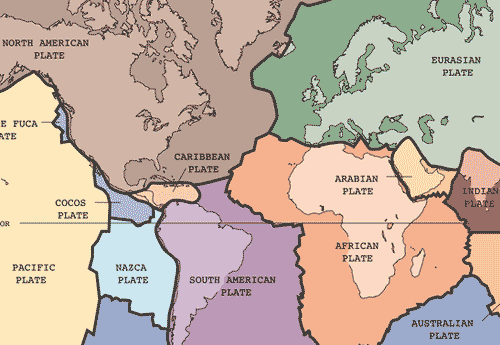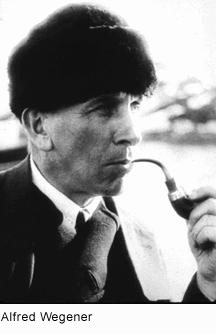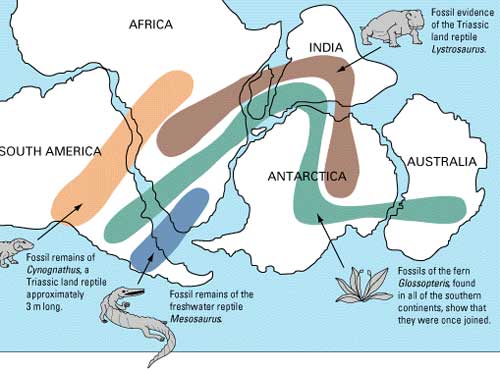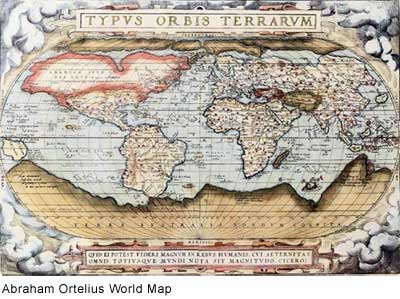|
The Big Puzzle: Earth’s crust is constantly on the move, drifting around the globe at a rate of several inches per year.
Believe it or not, scientists only discovered the whys and hows of “plate tectonics” in the 1960s! The term “plate” refers to large blocks of the Earth’s surface, which seem to move as a single unit. When plates move, they take the continents and the ocean floor along with them—that’s how each continent arrived at its current location! But if continents are continually drifting along with the plates beneath them, where have they been before and where are they going?

 The Past Lives of Continents: In 1912, meteorologist Alfred Wegener found clues revealing the history of the continents: the continents fit together, the rocks in distant parts of the globe show similar histories of climate change, and similar fossils were found around the world. Wegener realized that today’s continents are actually pieces of a giant continent that existed 200 million years ago! Wegener called this behemoth continent Pangaea, from the Greek for “all lands.” The Past Lives of Continents: In 1912, meteorologist Alfred Wegener found clues revealing the history of the continents: the continents fit together, the rocks in distant parts of the globe show similar histories of climate change, and similar fossils were found around the world. Wegener realized that today’s continents are actually pieces of a giant continent that existed 200 million years ago! Wegener called this behemoth continent Pangaea, from the Greek for “all lands.”
The Break Up: Alexander du Toit, a staunch supporter of Wegener’s theory, proposed that Pangaea first broke into two landmasses called Laurasia (in the northern hemisphere) and Gondwanaland (in the southern hemisphere). Laurasia and Gondwanaland then continued to break apart, yielding the 7 continents that exist today.
Wegener’s Clues:
The Continents Fit Together like Puzzle Pieces: Have you ever noticed that today’s continents look as if they are giant puzzle pieces that would fit together perfectly? Wegener observed that Africa ’s bulge fits snugly against the coast of North America , while Brazil fits perfectly along the coast of Africa . He suggested that the corresponding shapes of Earth’s continents reveal that the pieces were once a unified whole.
The Rocks Match: Huge chunks of rock on the costs of Africa and South America match precisely—if one were to put the two continents together like puzzle pieces, these matching rocks would rest side-by-side, confirming that the two continents are two pieces of one ancient whole.
Unexplained Climate Change: Wegener also noticed that there was evidence of dramatic climate changes on some continents. For example, archeologists discovered tropical plant fossils in Antarctica , suggesting that the frozen continent was once closer to the equator! Likewise, scientists also discovered fern fossils in the Polar Regions , and deposits from glaciers in present-day Africa ! Wegener believed that his continental drift theory was the best explanation for these, and many other, unexpected fossil findings.
The Plants and Animals Match: Wegener noticed that fossils from the Paleozoic era (544 to 245 million years ago) from different continents are often quite similar! In particular, he was fascinated by matching plant and animal fossils on the coastlines of South America and Africa . He realized that these animals had too much in common to have evolved independently. Also, it would have been impossible for most of these ancient organisms to travel across the vast ocean separating the two continents today. These identical fossil species presented compelling evidence that the two continents were joined when they evolved.

The Skeptics: The continents slowly drifted apart. Case closed, right? Even to the author of this article, it is hard to imagine vast continents drifting across the face of the Earth. To Wegener’s early 20 th century audience, the idea seemed downright crazy.
Until the 1700s, most Europeans believed that the Earth’s surface was shaped by a Biblical Flood. This theory was part of a larger set of beliefs called “catastrophism,” which held that all geological changes were sudden, and caused by a series of enormous catastrophes. In 1596, the Dutch map maker Abraham Ortelius suggested that the Americas were “torn away from Europe and Africa …by earthquakes and floods.” Still, neither Ortelius’ nor Wegener’s theories provided explanations which satisfied the increasingly well-informed 20 th century scientific community.

Wegener’s colleagues raised a host of questions that he was not able to answer: For example, they asked what forces are strong enough to move large masses of solid rock around the globe? Today, the theory of plate tectonics addresses this question with far greater accuracy than Wegener was able to muster.
The End… Stubborn in his beliefs, Wegener devoted the rest of his life to pursuing more evidence for continental drift. He froze to death in 1930 during an expedition over the Greenland ice cap, but his legacy lives on. New evidence from ocean floor exploration and other current research sparked renewed interest in Wegener’s strange theory. Today, the scientific community has embraced most of his ideas, and incorporated them into a comprehensive theory called plate tectonics.
…Or Just the Beginning? The continents drifted before the continent of Pangaea existed, and they continue to drift today! Many scientists now believe that the earth’s landmasses united and separated multiple times over the history of the earth. Continental drift may cause ice ages, impact ocean currents, and release greenhouse gases! Just because we don’t always feel the Earth shaking doesn’t mean it is ever at a stand-still. Our world is continually changing and animals and plants must evolve to suite the only world they’ve got.
|
